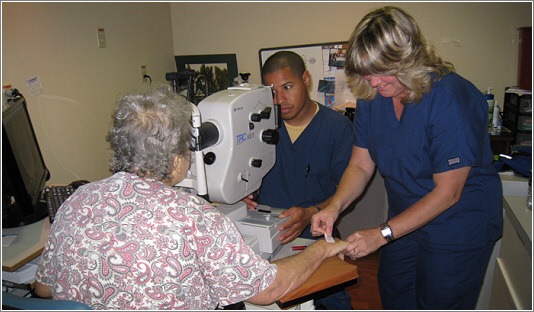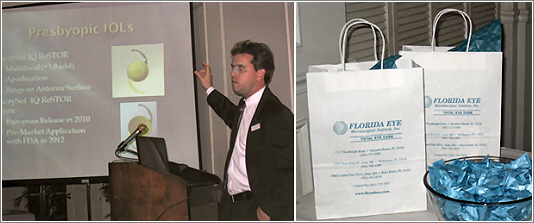Newsletter Issue 7 | Mar 2011
Florida Eye News and Views

Dear Readers:
Welcome to our March newsletter. Between our clinical trial studies, Lions Club eyeglass drive and continuing education classes, things have been nonstop for us at Florida Eye. We also recently formed the Florida Eye Education Foundation, Inc., a nonprofit 501(c)(3) organization which you’ll read more about in this newsletter.
As many of you may know, March is low-vision awareness month as well as AMD-awareness month. Dr. Randy Katz shares his opinions on the latest treatments available for this condition, including which ones are beneficial and which ones should be avoided by patients.
We hope you enjoy this issue and as always, if you need any information at all, I’m only an email ([email protected]) or phone call (561) 736-5050 away.
Best,

Gwen Cohan
Director of Marketing & Public Relations
In this Issue:
Hope for Those with Age-Related Macular Degeneration »
Update on Current Clinical Trials »
Florida Eye Education Foundation »
Update on Lions Club Eyeglasses Collection »
Continuing Education: PBCOA Seminar »
Cosmetic Specials at Florida Eye »
Hope for Those with Age-Related Macular Degeneration
Age-related macular degeneration (AMD) is the leading cause of visual impairment for individuals age 50 and older, and while there is still no cure, there is hope for those with AMD.
As part of Age-Related Macular Degeneration / Low-Vision Awareness Month in March, Florida Eye Microsurgical Institute’s Macular Degeneration & Diabetic Retinopathy Specialist Randy Katz, M.D. is urging those at risk to be screened for age-related vision problems by having regular eye exams and talking with their ophthalmologist about new treatments and low-vision resources, if experiencing vision loss.

Macular degeneration is a progressive, usually painless disease that affects the macula, the spot on the retina at the back of the eye responsible for central vision, causing central vision to blur, but leaving peripheral vision intact. Thus, AMD does not lead to total blindness.
“I urge everyone to know their risk factors. If you experience changes in your vision, such as straight lines appearing wavy, an inability to see details, dark or empty spots in the center of your vision or decreased ability to distinguish colors, see your ophthalmologist promptly,” says Dr. Katz, adding that those most at risk are individuals 50 years and older, people that suffer from hypertension, individuals who smoke and those with a family history of AMD.
“Research continues for AMD treatments, and I think we’ll see increasingly effective treatments becoming available in the near future. For example, current findings show that high levels of zinc and antioxidants can play a key role in slowing the progression of advanced AMD and that conventional laser and photodynamic therapy can reduce the risk of moderate to severe vision loss in patients with specific forms of ‘wet’ macular degeneration,” says Dr. Katz. “Other experimental treatments, including intraocular injections of antineovascular factors and the insertion of a ‘retinal chip,’ which may restore vision loss, are also currently being investigated.”
“Beware of claims being made on the Internet, in newspapers and in magazines announcing cures for macular degeneration. Investigate the claims thoroughly and talk with your ophthalmologist before undergoing any treatments,” adds Dr. Katz. “Most of these treatments have not been proven safe or effective and may be very costly.”
Vision loss does not have to mean loss of independence or quality of life. If you have low vision, ask your ophthalmologist about low-vision rehabilitation. He or she can provide low-vision services or refer you to an optometrist who specializes in low-vision treatments.
Early detection and treatment is the best defense against losing your vision. If you are at risk for macular degeneration, see your ophthalmologist for a complete eye exam at least every one to two years.
What is Wet AMD?
Wet AMD occurs when abnormal blood vessels behind the retina start to grow under the macula. These new blood vessels tend to be very fragile and often leak blood and fluid. The blood and fluid raise the macula from its normal place at the back of the eye. Damage to the macula occurs rapidly.
With wet AMD, loss of central vision can occur quickly. Wet AMD is also known as advanced AMD. It does not have stages like dry AMD.
An early symptom of wet AMD is that straight lines appear wavy. If you notice this condition or other changes to your vision, contact your eye-care professional at once. You need a comprehensive dilated eye exam.
What is Dry AMD?
Dry AMD occurs when the light-sensitive cells in the macula slowly break down, gradually blurring central vision in the affected eye. As dry AMD gets worse, you may see a blurred spot in the center of your vision. Over time, as less of the macula functions, central vision is gradually lost in the affected eye.
The most common symptom of dry AMD is slightly blurred vision. You may have difficulty recognizing faces. You may need more light for reading and other tasks. Dry AMD generally affects both eyes, but vision can be lost in one eye while the other eye seems unaffected.
One of the most common early signs of dry AMD is drusen.
What are Drusen?
Drusen are yellow deposits under the retina. They often are found in people over age 60. Your eye care professional can detect drusen during a comprehensive dilated eye exam.
Drusen alone do not usually cause vision loss. In fact, scientists are unclear about the connection between drusen and AMD. They do know that an increase in the size or number of drusen raises a person’s risk of developing either advanced dry AMD or wet AMD. These changes can cause serious vision loss.
Dry AMD has three stages, all of which may occur in one or both eyes:
- Early AMD. People with early AMD have either several small drusen or a few medium-sized drusen. At this stage, there are no symptoms and no vision loss.
- Intermediate AMD. People with intermediate AMD have either many medium-sized drusen or one or more large drusen. Some people see a blurred spot in the center of their vision. More light may be needed for reading and other tasks.
- Advanced Dry AMD. In addition to drusen, people with advanced dry AMD have a breakdown of light-sensitive cells and supporting tissue in the central retinal area. This breakdown can cause a blurred spot in the center of your vision. Over time, the blurred spot may get bigger and darker, taking more of your central vision. You may have difficulty reading or recognizing faces until they are very close to you.

[Preceding information provided by the National Eye Institute.]
Update on Current Clinical Trials
» From Dr. Barry Schechter:

Dry Eye, Pterygium Patients
We are currently enrolling patients in several new studies in a variety of eye-concern areas. The purpose of all of the studies is to evaluate new and promising ways to treat and alleviate these conditions.
Mild to Moderate Dry Eye
We are evaluating a mild topical NSAID based upon my prior research for a leading pharmaceutical corporation. We are also evaluating visco elastic vs. saline irrigation to close cataract surgery wounds.
Uncorrected Acuity
For our majority of patients who have excellent uncorrected acuity, we have another study that is evaluating uncorrected near and intermediate vision.
» From Dr. Randy Katz:
We currently have two Wet Macular Degeneration studies that are ongoing involving Lucentis plus a study drug. Treatment naïve with vision of 20/63 to 20/200.
We will also be participating in one clinical trial for dry ARMD beginning in April, and in the near future we will introduce at least one more new study for Wet AMD with eye drops.
A new study for Phase 4 Lucentis is starting in a few weeks, newly diagnosed, BRVO, CRVO or HRVO (different types of RVO). It lasts 15 months, study med for free and fellow eye treatment for free if needed. No previous treatment in the study eye with anti-VEGF therapy, no AMD, wet or dry, no laser or steroids within 4 months. VA between 20/40 and 20/320.
. . . . . . . . . . . . . .
As with any of our studies at Florida Eye, if you refer patients and they are enrolled, we will update you on the progress of your patient and return the patient to your care at the end of the study. The sponsor covers all expenses and costs of these trials.
If you would like to discuss these studies further, please contact our study coordinator Debbie Rankin at (561) 736-5055.
Florida Eye Education Foundation

Some of The Foundation’s goals include:
- Participating in community outreach programs such as health fairs and educational lectures, where eye care questions and concerns can be addressed.
- Working together with other business entities and nonprofits to raise awareness of preventable or treatable medical conditions such as diabetic retinopathy with the public at large.
- Treating patients who cannot afford medical/surgical services and/or medications.
- Sponsoring educational activities for optometrists to keep them informed and up-to-date on the most current ophthalmologic medical treatments, techniques, equipment and procedures available to their own practices and patients.
For more information about The Foundation contact Gwen at 561-736-5050.
Florida Eye Education Foundation, Inc. is a 501(c)(3) Nonprofit Organization. A copy of the official registration and financial information may be obtained from the Division of Consumer Services by calling toll free (800-435-7352) within the state. Registration does not imply endorsement, approval, or recommendation by the state.
Update on Lions Club Eyeglasses Collection

According to The World Health Organization, 153 million people have uncorrected refractive errors (near-sightedness, far-sightedness or astigmatism). Most of these vision impairments are quickly diagnosed and easy to treat with corrective lenses.
Still, millions of people in developing nations are pushed deeper into poverty simply because they don’t have glasses. They can’t learn, because reading is difficult. They can’t work to the best of their ability, because they can’t see clearly.
It costs Lions less than eight cents to provide a pair of recycled eyeglasses and change someone’s life.
For children, clear vision means a better education, healthier development and a better quality of life. For adults, it means greater employment opportunity and economic strength. For seniors it means less dependence on others.
Lions clubs collect millions of eyeglasses each year, making eyeglass recycling one of its most popular activities, and it is our pleasure to assist them with their efforts.

Continuing Education: PBCOA Seminar
Florida Eye recently sponsored the PBCOA meeting at The Players Club in Wellington. Dr. Jason Gorscak presented “Refractive Cataract Surgery in 2011 and Beyond,” which was very well received by those in attendance. Our next CE will be scheduled in early fall of 2011.

Eye Care Questions
Dear Dr. Katz:
What are the warning signs of a retinal detachment? My son was hit fairly hard on the side of his head with the soccer ball during a game, and I want to make sure that he doesn’t have any problems.
Answer

A retinal detachment occurs when the retina is pulled away from its normal position. The retina does not work when it is detached. Vision is blurred, just as a photographic image would be blurry if the film were loose inside the camera. A retinal detachment can be the result of a trauma, such as a blow to the head, or can happen spontaneously. Individuals with myopia or nearsightedness have a higher risk of retinal detachment. Some early symptoms that may indicate the presence of a retinal detachment include flashing lights, floaters, a shadow in the periphery of your field of vision or a gray or dark curtain moving across your field of vision. These symptoms do not always mean a retinal detachment is present; however, you should still see your ophthalmologist as soon as possible to find out if a retinal tear or early retinal detachment is present.
Dear Dr. Schechter:
I recently heard that the newest thinking about cataracts was that it was best to have them removed early in their development, rather than waiting for them to more fully develop. Is that true? My doctor has told me to wait for them to get worse before operating. I am a little confused and wonder if I should have someone else look.
Answer

I think you are getting good advice from your present doctor. Although a cataract can be removed early, if you are not having any difficulty with your vision, there is no reason to remove it. Most patients have slight cataracts as they get into their late 60s and 70s, and the cataracts usually develop slowly. In fact, insurance regulations require problems with some aspect of your vision, like reading or driving a car for example, to justify payment for cataract surgery. Early cataracts that are removed to eliminate the need for glasses are considered “refractive lensectomy” and the expense of the surgery should be paid for by the patient rather than by the insurance company. Since there is always a slight risk with cataract surgery, you must balance the minimal risk with the potential benefit before proceeding with surgery.
Dear Dr. Friedman:
My 12-year-old son has been prescribed glasses for myopia. If he does not wear his glasses, will his eyes deteriorate further?
Answer

Clinical consensus is that your son will not develop more refractive error because of his refusal to wear eyeglasses. However, it will be difficult to see far away and school performance could suffer, so I would make it a point to convince him to wear his glasses.
Dear Dr. Gorscak:
Is it true that as women get older, their night vision deteriorates?
Answer

Both men and women may experience difficulties with night vision associated with aging. Often times these symptoms can be lessened by appropriate glasses or by just using good lighting for certain tasks. It is important to have a complete eye exam to rule out cataracts, glaucoma, and macular degeneration as causing symptoms that might be associated with or confused with “night blindness.” Vitamin deficiencies and retinitis pigmentosa may also lead to problems with night vision and can be diagnosed by an ophthalmologist.
Dear Dr. Chua:
Are pink eye and conjunctivitis the same thing?
Answer

The two conditions overlap. Pink eye is an infectious form of conjunctivitis, most often caused by viruses but also caused in some cases by bacteria. The most important form of non-infectious conjunctivitis is allergic, usually recognizable by mild redness, substantial itching and no discharge.
Cosmetic Specials at Florida Eye
Visit DrBarrySchechter.com for cosmetic specials and additional information.
Barry A. Schechter, M.D., F.A.A.O.
Refractive Cataract Surgery, Glaucoma, Cornea & External Disease Specialist
Final Tidbets
Congratulations to Florida Eye’s Dr. Jennifer Garib and V.J. Sreeram, who welcomed their baby daughter Anjali Sreeram this past January 16th, 2011!
Anjali already has quite the sense of humor!!

